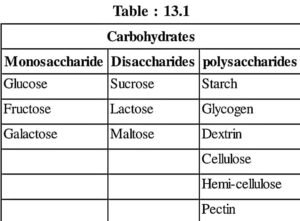Carbohydrate | Definition, Classification, Functions & Examples
What is Carbohydrates —
- Carbohydrates is a major part of our food. A person takes 55-65% energy from carbohydrates present in the food. Carbohydrates are cheap and simple source of energy. The main source of carbohydrates is vegetation. Green leaves using carbon dioxide and water, in the presence of chlorophyll pigment and sunlight, form carbohydrates (C.H,,0,). These carbohydrates are stored in the form of sugar, starch, cellulose and hemi-cellulose.
Chlorophyll + 6CO2 + 6H2 0 + sunlight = photosynthesis = C2 H12 06 + 602
carbohydrate Chemical Formation —
- The basic constituting unit of carbohydrate is sugar in which carbon, hydrogen and oxygen elements are present. The ratio of hydrogen and oxygen is same as water. That is why it is named carbohydrate. Its chemical formula is Cn (H2 0)n
Classification of carbohydrates —
Carbohydrates are classified on the basis of molecular structure—

1. Monosaccharides —
This simple type of carbohydrate is made up of two words— Mono + saccharide or one sugar. After digestion all forms of carbohydrate changes into simple sugar form. There are 6 carbons. That is why they are called as hexoses. The three main hexoses are—
- Glucose— Glucose is also called as Dextrose, ‘blood sugar’ or ‘grape sugar’. Most of the carbohydrates in the body get converted into glucose and give energy.
- Fructose— Fructose is also called as “fruit sugar’. This is the sweetest of all sugars. It gets absorbed by the body very fast.
- Galactose— This is not present individually but in combination with other food items. Milk sugar lactose is made up of one molecule glucose and one molecule galactose. It is not found in any vegetation.
2. Disaccharides —
When two molecules of monosaccharide combine by a condensation process then formation of disaccharides take place.
- Sucrose— Sucrose is formed using sugarcane Jjuice or beetroot. Sucrose — glucose+fructose (sucrase enzyme) Maltose— It is formed from two molecules of glucose. It is also known as malt sugar and is formed during germination of grains.
- Maltose — glucose + glucose (maltase enzyme) Lactose— It is also known as milk sugar. It is less sweet and is less soluble in water compared to other sugars. Lactose — glucose + galactose (lactase enzyme)
3. Polysaccharides—
These are complex carbohydrates. That is why these are easily stored in plants and trees. From the point of nutrition starch, dextrin, cellulose, glycogen, pectin, hemicelluloses are main sugars.
- Starch— Starch is mainly made of amylase and amylopectin. Plants and trees are the main sources of starch. Starch is present in cereals like wheat, rice, millet, stem and root vegetables, dried seeds, peas; apple etc. in uncooked fruits carbohydrate is present in the form of starch which on cooking it changes into sweet sugar (mono and disaccharides).
- Glycogen— Glycogen is also called as ‘animal starch’. It is present in liver and muscles of living humans and animals. It changes into glucose when need arises.
- Dextrin— It is obtained by partial hydrolysis of starch. It is less complex than starch. It is present in corn sugar, corn syrup, and honey. Starch — dextrin — maltose — glucose
- Cellulose—It is made up of many glucose units. Tt is present in cell walls. It is not digested in the human body. But it is helpful in maintaining contraction and relaxation rate and functioning of intestines and muscles. It is present in adequate quantities in bran flour, whole grains, salad, etc.
- Hemi-cellulose— This is not digested in the human body. But it is important for the health of the intestines. It is found sufficiently in shelled pulses and grains. Pectin— It is present in the peels of ripened fruits and some root vegetables. This too like cellulose and hemi-cellulose does not get digested in human body. It is important for making jam and jelly in fruit industry.
Functions of carbohydrates —
- Providing energy— The main function of carbohydrate is providing energy. lgram carbohydrates give 4.2 kilocalories of energy. It is the main source of energy. The excess of carbohydrates is stored as glycogen in liver and muscles which gets converted into glucosewhen need arises.
- Protein saving—The main function of protein is growth and development of body. But in the absence of carbohydrate and fat protein starts breaking to provide energy. As a result, formative functions of protein are affected.
- Synthesis of vitamin B group— Lactose is essential for synthesis of vitamin B. The bacteria present in small intestines are auxiliary in the synthesis of vitamin B.
- In maintaining health of digestive system— Cellulose, hemi-cellulose, pectin, etc are not digested by human body but these are important for cleaning the stomach and maintaining the contraction and relaxation rate of intestines which prevents constipation
- Absorption of calcium— Lactose present in milk is less soluble than other sugars and it gets converted into lactic acid in the presence of bacteria and increases the acidic medium important for absorption of calcium.
- Other functions— Glucose helps in completion of oxygenation of fats and increase the use of fats. Consumption of fibrous and complex carbohydrates reduces blood cholesterol and glucose which in turn reduces chances of heart diseases and diabetes. Carbohydrates help in keeping liver and vascular system healthy and in removal of harmful substances.
Sources— All types of cereals— wheat, rice, millets, maize, some lentils, sugar, jaggery, honey; root vegetables such as potatoes, sweet potato, beetroot, taro root; dry fruits such as— raisins, figs, dates, apples, cottage cheese, etc. are main sources of carbohydrates.
Effects of deficiency—
55-66% of total energy required should be taken from carbohydrates present in the daily diet. In the absence of carbohydrate and fat, protein breaks up to provide energy. As a result the main function of protein becomes secondary. Thus, the growth and development is disrupted. Other effects are—
- 1. Loss of weight.
- 2. Lethargy, irritation and nervous behaviour.
- 3. Less physical activities
- 4. Occurrence of digestive system related disorders.
Effects of excess of carbohydrates—
- Excess of carbohydrates in food gets stored as fat in the body and leads to obesity. The working capacity reduces. Obesity leads to diseases such as heart disease, diabetes, ketosis, etc.
Importance of fibers in food—
1. The fibers (cellulose, hemi-cellulose, pectin, and lignin) present in food substances are not easily digested. Therefore, they do not provide energy and reduces the energy value of food. Low energy but fiber rich food substance only give satisfaction of eating.
2. Fibers present in food increase the rate of contraction and relaxation of intestines and solve the problem of constipation.
3. Fibers in the food get combined with other nutrients and reduce the absorption of those nutrients in the intestines, as a result they help in maintaining low levels of blood glucose and cholesterol. That is why fiber rich food is especially important for diabetic and people with heart diseases. These fibers combine with cholesterol from the gall bladder and reduce the rate of absorption of food. They synthesize vitamins in the intestines. The decomposition products of fats by bacteria in intestines keep the intestines and mucous membrane healthy and prevent intestinal cancer.
Sources— Fresh fruits, vegetables, green leafy vegetables, whole grains and lentils are good sources of fibers.
Home Science Latest Post :- Click Here
Nutrients – Macronutrients Questions and Answers :-
Question 1. The hydroponic method was discovered by:
(a) Sachs
(b) Hogland
(c) Knop
(d) Webster
Click to show/hide
Question 2. ‘Die back’ disease is caused due to deficiency of:
(a) K
(b) Cu
(c) B
(d) Fe
Click to show/hide
Question 3. The insectivorous plants catch insects to fulfil their need of:
(a) O
(b) C
(c) N
(d) K
Click to show/hide
Question 4. Nitrogen is the essential component of:
(a) carbohydrates
(b) fat
(c) protein
(d) oil
Click to show/hide
Question 5. The brown colour of leaves of cabbage is due to the deficiency of:
(a) boron
(b) nitrogen
(c) sulphur
(d) calcium
Answer :- ?????
